When you shop through links on our site, we may earn an affiliate commission. This educational content is not intended to be a substitute for professional advice.
20 Best Books On Deep Learning (2023 Update)
Are you looking for the Best Books On Deep Learning? If so, you’ve come to the right place.
Choosing the Best Books On Deep Learning can be difficult as there are so many considerations, such as Apple, Elsevier, Jellycat, LEGO, Melissa & Doug, Penguin Random House, WHSmith, Amazon.com. We have done a lot of research to find the Top 20 Best Books On Deep Learning available.
The average cost is $34.00. Sold comparable range in price from a low of $5.90 to a high of $62.99.
Based on the research we did, we think Deep Learning: A Practitioner's Approach [Book] is the best overall. Read on for the rest of the great options and our buying guide, where you can find all the information you need to know before making an informed purchase.
20 Best Books On Deep Learning (19 Sellers)
| Product Image | Product Name | Features | Check Price |
|---|---|---|---|
|
|||
|
|||
|
|||
|
|||
|
|||
|
|||
|
|||
|
|||
|
|||
|
|||
|
|||
|
|||
|
|||
|
|||
|
|||
|
|||
|
|
||
|
|||
|
|||
|
|
Features:
- Dive into machine learning concepts in general, as well as deep learning in particular
- Understand how deep networks evolved from neural network fundamentals
- Explore the major deep network architectures, including convolutional and recurrent
Features:
- Using the pytorch tensor api
- Understanding automatic differentiation in pytorch
- Training deep neural networks
Features:
- Train models in computer vision, natural language processing, tabular data, and collaborative filtering
- Learn the latest deep learning techniques that matter most in practice
- Improve accuracy, speed, and reliability by understanding how deep learning models work
Features:
- Binding type: paperback
- Year published: 2022-07-26
- Number of pages: 568
Features:
- Format: ebook
- Rental duration: lifetime
- Author: amita kapoor; antonio gulli; sujit pal; francois chollet
Features:
- You have to plunge in the water of machine learning for a few years before coming back.
- Don't talk to me if it's not a doctor of the computer!-getting started is simple: 10 years of experience should be almost enough. it's probably enough.
- To sum it up: only great gods can do deep learning.
Features:
- About the book.
- A project-based guide to the basics of deep learning.
- Book synopsis.
Features:
- The dust jacket if present may be marked and have considerable heavy wear or might be missing.
- The book might be ex-library copy and may have the markings and stickers associated from the library.
- The book may have considerable highlights/notes/underlined pages but the text is legible.
Features:
- Grand central pub
- Brand: grand central publishing
- Easy to understand
Features:
- Binding type: paperback
- Year published: 2019-09-02
- Number of pages: 296
Features:
- Care instruction: keep away from fire.
- It can be used as a gift.
- It is made up of premium quality material.
Features:
- Key features.
- Structuring problems as markov decision processes.
- Popular algorithms such deep q-networks, policy gradient method and evolutionary algorithms and the intuitions that drive them.
Features:
- Build machine and deep learning systems with the newly released tensorflow 2 and keras for the lab, production, and mobile devices
- Key features
- What you will learn
Features:
- Explore and master core concepts: perceptrons, gradient-based learning, sigmoid neurons, and back propagation
- See how dl frameworks make it easier to develop more complicated and useful neural networks
- Discover how convolutional neural networks (cnns) revolutionize image classification and analysis
Features:
- Use matlab for deep learning
- Discover neural networks and multi-layer neural networks
- Work with convolution and pooling layers
$23.49
5.0
Features:
- The deep learning framework
- Vignettes and case studies from k-12 classrooms in 1,200 schools in seven countries
- Guidance for reaching disadvantaged and differently abled students
$62.99
4.7
Features:
- By: ian goodfellow; yoshua bengio; aaron courville
- The mit press
- Print isbn: 9780262035613, 0262035618
$17.99
5.0
Features:
- Explore the machine learning landscape, particularly neural nets
- Use scikit-learn to track an example machine-learning project end-to-end
- Explore several training models, including support vector machines, decision trees, random forests, and ensemble methods
$5.90
5.0
Features:
- Explore the machine learning landscape, particularly neural nets
- Use scikit-learn to track an example machine-learning project end-to-end
- Explore several training models, including support vector machines, decision trees, random forests, and ensemble methods
$8.00
4.9
Features:
- Deep learning from first principles
- Setting up your own deep-learning environment
- Image classification and generation
1. Deep Learning: A Practitioner's Approach [Book]

Product Details:
Although interest in machine learning has reached a high point, lofty expectations often scuttle projects before they get very far. how can machine learning–especially deep neural networks–make a real difference in your organization? this hands-on guide not only provides the most practical information available on the subject, but also helps you get started building efficient deep learning networks. – authors adam gibson and josh patterson provide theory on deep learning before introducing their open-source deeplearning4j (dl4j) library for developing production-class workflows. through real-world examples, you'll learn methods and strategies for training deep network architectures and running deep learning workflows on spark and hadoop with dl4j.dive into machine learning concepts in general, as well as deep learning in particular – understand how deep networks evolved from neural network fundamentals – explore the major deep network architectures, including convolutional and recurrent – learn how to map specific deep networks to the right problem – walk through the fundamentals of tuning general neural networks and specific deep network architectures – use vectorization techniques for different data types with data – vec, dl4j's workflow tool – learn how to use dl4j natively on spark and hadoop
Reviews:
The book is of good quality – as advertised. Highly recommend!gnans_lg
2. Deep Learning With Pytorch: Build, Train, And Tune Neural Networks Using Python Tools [Book]
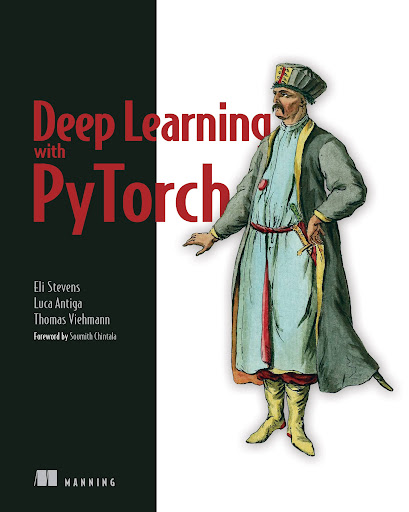
Product Details:
It covers the basics and abstractions in great detail. i hope this book becomes your extended reference document.” —soumith chintala, co-creator of pytorch key features written by py – torch’s creator and key contributors develop deep learning models in a familiar pythonic way use pytorch to build an image classifier for cancer detection diagnose problems with your neural network and improve training with data augmentation purchase of the print book includes a free ebook in pdf, kindle, and e – pub formats from manning publications. pytorch puts these superpowers in your hands. instantly familiar to anyone who knows python data tools like num – py and scikit-learn, pytorch simplifies deep learning without sacrificing advanced features. it’s great for building quick models, and it scales smoothly from laptop to enterprise. deep learning with pytorch teaches you to create deep learning and neural network systems with pytorch. this practical book gets you to work right away building a tumor image classifier from scratch. after covering the basics, you’ll learn best practices for the entire deep learning pipeline, tackling advanced projects as your pytorch skills become more sophisticated. all code samples are easy to explore in downloadable jupyter notebooks. what you will learn understanding deep learning data structures such as tensors and neural networks best practices for the pytorch tensor api, loading data in python, and visualizing results implementing modules and loss functions utilizing pretrained models from pytorch hub methods for training networks with limited inputs sifting through unreliable results to diagnose and fix problems in your neural network improve your results with augmented data, better model architecture, and fine tuning this book is written for for python programmers with an interest in machine learning. no experience with pytorch or other deep learning frameworks is required. about the authors eli stevens has worked in silicon valley for the past 15 years as a software engineer, and the past 7 years as chief technical officer of a startup making medical device software. luca antiga is co-founder and ceo of an ai engineering company located in bergamo, italy, and a regular contributor to pytorch. thomas viehmann is a machine learning and pytorch speciality trainer and consultant based in munich, germany and a pytorch core developer. table of contents part 1 – core pytorch 1 introducing deep learning and the pytorch library 2 pretrained networks 3 it starts with a tensor 4 real-world data representation using tensors 5 the mechanics of learning 6 using a neural network to fit the data 7 telling birds from airplanes: learning from images 8 using convolutions to generalize part 2 – learning from images in the real world: early detection of lung cancer 9 using pytorch to fight cancer 10 combining data sources into a unified dataset 11 training a classification model to detect suspected tumors 12 improving training with metrics and augmentation 13 using segmentation to find suspected nodules 14 end-to-end nodule analysis, and where to go next part 3 – deployment 15 deploying to production
Reviews:
Great book to be introduced into machine learning and PyTorchEduardo Mosqueira R
excellent, it arrived ahead of time and I think the price is fair.Monse
3. Deep Learning For Coders With Fastai And Pytorch: Ai Applications Without A Phd [Book]
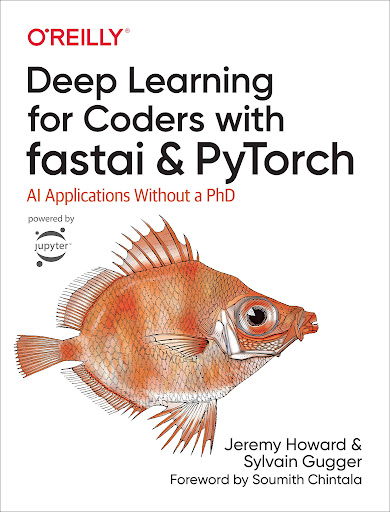
Product Details:
Deep learning is often viewed as the exclusive domain of math ph – ds and big tech companies. but as this hands-on guide demonstrates, programmers comfortable with python can achieve impressive results in deep learning with little math background, small amounts of data, and minimal code. how? with fastai, the first library to provide a consistent interface to the most frequently used deep learning applications. – authors jeremy howard and sylvain gugger, the creators of fastai, show you how to train a model on a wide range of tasks using fastai and pytorch. you'll also dive progressively further into deep learning theory to gain a complete understanding of the algorithms behind the scenes. – train models in computer vision, natural language processing, tabular data, and collaborative filtering – learn the latest deep learning techniques that matter most in practice – improve accuracy, speed, and reliability by understanding how deep learning models work – discover how to turn your models into web applications – implement deep learning algorithms from scratch – consider the ethical implications of your work – gain insight from the foreword by pytorch cofounder, soumith chintala
Reviews:
4. Deep Learning With R, Second Edition [Book]
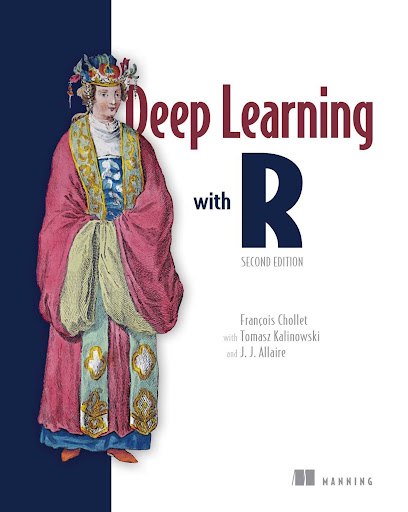
Product Details:
Deep learning from the ground up using r and the powerful keras library! in deep learning with r, second edition you will learn: deep learning from first principles image classification and image segmentation time series forecasting text classification and machine translation text generation, neural style transfer, and image generation deep learning with r, second edition shows you how to put deep learning into action. it’s based on the revised new edition of françois chollet’s bestselling deep learning with python. all code and examples have been expertly translated to the r language by tomasz kalinowski, who maintains the keras and tensorflow r packages at rstudio. novices and experienced ml practitioners will love the expert insights, practical techniques, and important theory for building neural networks. purchase of the print book includes a free ebook in pdf, kindle, and epub formats from manning publications. about the technology deep learning has become essential knowledge for data scientists, researchers, and software developers. the r language apis for keras and tensorflow put deep learning within reach for all r users, even if they have no experience with advanced machine learning or neural networks. this book shows you how to get started on core dl tasks like computer vision, natural language processing, and more using r. about the book deep learning with r, second edition is a hands-on guide to deep learning using the r language. as you move through this book, you’ll quickly lock in the foundational ideas of deep learning. the intuitive explanations, crisp illustrations, and clear examples guide you through core dl skills like image processing and text manipulation, and even advanced features like transformers. this revised and expanded new edition is adapted from deep learning with python, second edition by françois chollet, the creator of the keras library. what's inside image classification and image segmentation time series forecasting text classification and machine translation text generation, neural style transfer, and image generation about the reader for readers with intermediate r skills. no previous experience with keras, tensorflow, or deep learning is required. about the author françois chollet is a software engineer at google and creator of keras. tomasz kalinowski is a software engineer at rstudio and maintainer of the keras and tensorflow r packages. allaire is the founder of rstudio, and the author of the first edition of this book. table of contents 1 what is deep learning? 2 the mathematical building blocks of neural networks 3 introduction to keras and tensorflow 4 getting started with neural networks: classification and regression 5 fundamentals of machine learning 6 the universal workflow of machine learning 7 working with keras: a deep dive 8 introduction to deep learning for computer vision 9 advanced deep learning for computer vision 10 deep learning for time series 11 deep learning for text 12 generative deep learning 13 best practices for the real world 14 conclusions
Reviews:
Interesting and usefull for my work
5. Deep Learning With Tensorflow And Keras: Build And Deploy Supervised, Unsupervised, Deep, And Reinforcement Learning Models [Book]
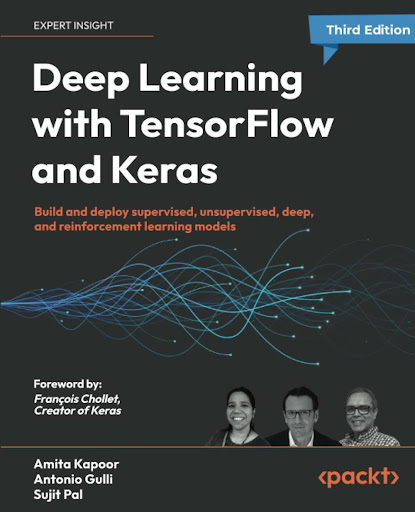
Product Details:
Build cutting edge machine and deep learning systems for the lab, production, and mobile devices – key features: understand the fundamentals of deep learning and machine learning through clear explanations and extensive code samples – implement graph neural networks, transformers using hugging face and tensorflow hub, and joint and contrastive learning – learn cutting-edge machine and deep learning techniques – book description: deep learning with tensorflow and keras teaches you neural networks and deep learning techniques using tensorflow (tf) and keras. this book uses the latest tf 2.0 features and libraries to present an overview of supervised and unsupervised machine learning models and provides a comprehensive analysis of deep learning and reinforcement learning models using practical examples for the cloud, mobile, and large production environments. – this book also shows you how to create neural networks with tensorflow, runs through popular algorithms (regression, convolutional neural networks (cnns), transformers, gans, recurrent neural networks (rnns), natural language processing (nlp), and graph neural networks (gnns)), covers working example apps, and then dives into tf in production, tf mobile, and tensorflow with auto – ml.what you will learn: learn how to use the popular gnns with tensorflow to carry out graph mining tasks – discover the world of transformers, from pretraining to fine-tuning to evaluating them – apply self-supervised learning to natural language processing, computer vision, and audio signal processing – combine probabilistic and deep learning models using tensorflow probability – train your models on the cloud and put tf to work in real environments – build machine learning and deep learning systems with tensorflow 2.x and the keras apiwho this book is for: this hands-on machine learning book is for python developers and data scientists who want to build machine learning and deep learning systems with tensorflow. this book gives you the theory and practice required to use keras, tensorflow, and auto – ml to build machine learning systems. – some machine learning knowledge would be useful.
6. Deep Learning With Python: Comprehensive Guide Of Tips And Tricks Using Deep Learning With Python Theories [Book]
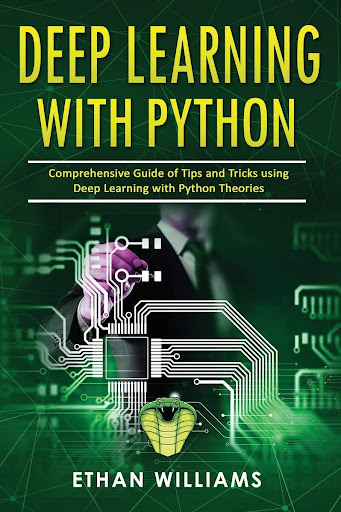
Product Details:
This book is designed to help you use python for deep learning, including how to build and run deep learning models using keras. this book also includes deep learning techniques, sample code, and technical content.the mathematical foundations of deep learning are subtle: but the average user doesn't need to fully understand the mathematical details to pick up the keyboard and start programming. practically speaking, deep learning is not complicated, but the results are very objective. teach you how to use deep learning: this is the purpose of this book.deep learning: how to get started wrong! if you ask the big guys how to get started with deep learning, what will they say? nothing more than: -linear algebra is the key!-you have to understand traditional neural networks to do it!-probability and statistics are the foundation, aren't they?-you have to plunge in the water of machine learning for a few years before coming back.-don't talk to me if it's not a doctor of the computer!-getting started is simple: 10 years of experience should be almost enough. it's probably enough.-to sum it up: only great gods can do deep learning.net tm nonsense!
Specifications:
| Language | English |
| Release Date | April 2016 |
| Length | 370 Pages |
| Dimensions | 0.9" x 6.1" x 9.2" |
7. Introduction To Deep Learning [Book]

Product Details:
A project-based guide to the basics of deep learning.this concise, project-driven guide to deep learning takes readers through a series of program-writing tasks that introduce them to the use of deep learning in such areas of artificial intelligence as computer vision, natural-language processing, and reinforcement learning. the author, a longtime artificial intelligence researcher specializing in natural-language processing, covers feed-forward neural nets, convolutional neural nets, word embeddings, recurrent neural nets, sequence-to-sequence learning, deep reinforcement learning, unsupervised models, and other fundamental concepts and techniques. students and practitioners learn the basics of deep learning by working through programs in tensorflow, an open-source machine learning framework. “i find i learn computer science material best by sitting down and writing programs,” the author writes, and the book reflects this approach.each chapter includes a programming project, exercises, and references for further reading. an early chapter is devoted to tensorflow and its interface with python, the widely used programming language. familiarity with linear algebra, multivariate calculus, and probability and statistics is required, as is a rudimentary knowledge of programming in python. the book can be used in both undergraduate and graduate courses; practitioners will find it an essential reference.
Specifications:
| Dimensions | 178 x 229 x 21mm | 544.31g |
| Imprint | MIT Press |
| Publication City/Country | Cambridge, United States |
| Language | English |
| Illustrations note | 75 b&w illus. 150 Illustrations, unspecified |
8. Deep Learning With Python, Second Edition [Book]
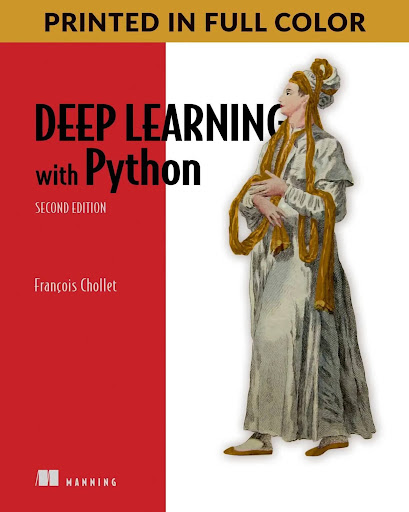
Product Details:
Printed in full color! unlock the groundbreaking advances of deep learning with this extensively revised new edition of the bestselling original. learn directly from the creator of keras and master practical python deep learning techniques that are easy to apply in the real world.in deep learning with python, second edition you will learn: deep learning from first principles image classification and image segmentation timeseries forecasting text classification and machine translation text generation, neural style transfer, and image generation full color printing throughout deep learning with python has taught thousands of readers how to put the full capabilities of deep learning into action. this extensively revised full color second edition introduces deep learning using python and keras, and is loaded with insights for both novice and experienced ml practitioners. you’ll learn practical techniques that are easy to apply in the real world, and important theory for perfecting neural networks. purchase of the print book includes a free ebook in pdf, kindle, and epub formats from manning publications. about the technology recent innovations in deep learning unlock exciting new software capabilities like automated language translation, image recognition, and more. deep learning is quickly becoming essential knowledge for every software developer, and modern tools like keras and tensorflow put it within your reach—even if you have no background in mathematics or data science. this book shows you how to get started. about the book deep learning with python, second edition introduces the field of deep learning using python and the powerful keras library. in this revised and expanded new edition, keras creator françois chollet offers insights for both novice and experienced machine learning practitioners. you’ll quickly pick up the skills you need to start developing deep-learning applications. what's inside deep learning from first principles image classification and image segmentation time series forecasting text classification and machine translation text generation, neural style transfer, and image generation full color printing throughout about the reader for readers with intermediate python skills. no previous experience with keras, tensorflow, or machine learning is required. about the author françois chollet is a software engineer at google and creator of the keras deep-learning library. table of contents 1 what is deep learning? 2 the mathematical building blocks of neural networks 3 introduction to keras and tensorflow 4 getting started with neural networks: classification and regression 5 fundamentals of machine learning 6 the universal workflow of machine learning 7 working with keras: a deep dive 8 introduction to deep learning for computer vision 9 advanced deep learning for computer vision 10 deep learning for timeseries 11 deep learning for text 12 generative deep learning 13 best practices for the real world 14 conclusions
Reviews:
I really like how everything was structured and written really well! I am very new to this subject and have very limited experience working with python but this book guides you like a real tutor. Also, as a machine learning newbie, the author assured the reader in the book that not understanding in the beginning is ok and we just have to start somewhere which is very true!Anwar
9. Deep Work: Rules For Focused Success In A Distracted World [Book]

Product Details:
Deep work : hardback : grand central publishing : 9781455586691 : 1455586692 : 05 jan 2016 : deep work is the ability to focus without distraction on a cognitively demanding task. it's a skill that allows you to quickly master complicated information and produce better results in less time. in this book, newport flips the narrative on impact in a connected age. instead of arguing distraction is bad, he instead celebrates the power of its opposite. dividing this book into two parts, he first makes the case that in almost any profession, cultivating a deep work ethic will produce massive benefits. he then presents a rigorous training regimen, presented as a series of four rules, for transforming your mind and habits to support this skill.
Reviews:
The concepts explained in this book are so relevant and logical. It is such a challenge to get out of the 'shallow work' we are faced with throughout our days and into the 'deep' but this book spells out how and shows you the benefits that will flow. I read this book in record time and started implementing the concepts immediately.Darren in the Deep
Another book recommended to me by a friend. Being a researcher by trade, Deep Work reminds me of the importance of my role – the ability o do sustained and concentrative work. This book goes through the reasons why most of us are transforming our work lives from deep to shallow work. As Cal Newport states – Shallow Work stops us from getting fired; Deep Work gets us promoted. A great book for anyone wondering why they aren't achieving their desired outputs and how to find more value to get to the next desired levelAngela
10. Dive Into Deep Learning: Tools For Engagement [Book]

Product Details:
The leading experts in system change and learning, with their school-based partners around the world, have created this essential companion to their runaway best-seller, deep learning: engage the world change the world. this hands-on guide provides a roadmap for building capacity in teachers, schools, districts, and systems to design deep learning, measure progress, and assess conditions needed to activate and sustain innovation. dive into deep learning: tools for engagement is rich with resources educators need to construct and drive meaningful deep learning experiences in order to develop the kind of mindset and know-how that is crucial to becoming a problem-solving change agent in our global society. designed in full color, this easy-to-use guide is loaded with tools, tips, protocols, and real-world examples. it includes: * a framework for deep learning that provides a pathway to develop the six global competencies needed to flourish in a complex world — character, citizenship, collaboration, communication, creativity, and critical thinking. * learning progressions to help educators analyze student work and measure progress. * learning design rubrics, templates and examples for incorporating the four elements of learning design: learning partnerships, pedagogical practices, learning environments, and leveraging digital. * conditions rubrics, teacher self-assessment tools, and planning guides to help educators build, mobilize, and sustain deep learning in schools and districts. learn about, improve, and expand your world of learning. put the joy back into learning for students and adults alike. dive into deep learning to create learning experiences that give purpose, unleash student potential, and transform not only learning, but life itself.
Reviews:
Workbook that is completed with collaboration…2freakfly
11. Deep Learning With Python [Book]
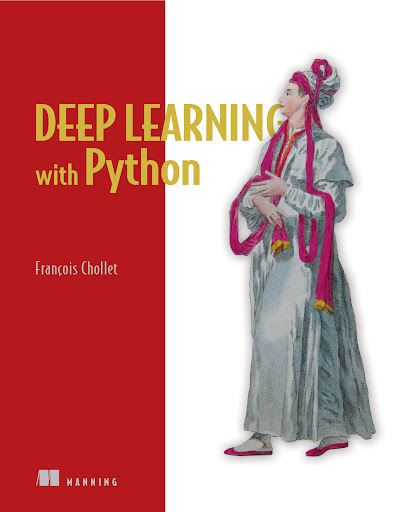
Product Details:
Summary deep learning with python introduces the field of deep learning using the python language and the powerful keras library. purchase of the print book includes a free ebook in pdf, kindle, and epub formats from manning publications. about the technology machine learning has made remarkable progress in recent years. behind this progress is deep learning—a combination of engineering advances, best practices, and theory that enables a wealth of previously impossible smart applications. about the book deep learning with python introduces the field of deep learning using the python language and the powerful keras library. you'll explore challenging concepts and practice with applications in computer vision, natural-language processing, and generative models. by the time you finish, you'll have the knowledge and hands-on skills to apply deep learning in your own projects. what's inside deep learning from first principles setting up your own deep-learning environment image-classification models deep learning for text and sequences neural style transfer, text generation, and image generation about the reader readers need intermediate python skills. no previous experience with keras, tensorflow, or machine learning is required. about the author françois chollet is one of the most important researchers in modern day deep learning. his groundbreaking work includes the creation of the keras deep learning library, and major contributions to the tensorflow framework. these tools have helped revolutionize and democratize deep learning. françois is an ai researcher and senior staff software engineer at google. françois authored deep learning with r alongside j.j. allaire, and developed the abstraction and reasoning challenge that measures ai skill-acquisition on unknown tasks. table of contents what is deep learning? our rich and independent history is filled with innovations, including groundbreaking early access programs, drm-free ebooks, and live learning projects. manning authors are technology experts, including distinguished academics, industry veterans, and the creators of major tools. timeless manning classics include francois chollet’s deep learning with python, jon skeet’s c# in depth, don jones’ learn windows powershell in a month of lunches, and chris richarson’s microservices patterns.
Reviews:
This has a big emphasis on practice and I like it . It starts from fandemntal examples and slowly advances without missing any peice of important informaition. I feel that my ability to implement learning Algorithm greatly improved. It does lack in the theory department , wich I think is important. Thank youAriel T
12. Deep Reinforcement Learning In Action [Book]
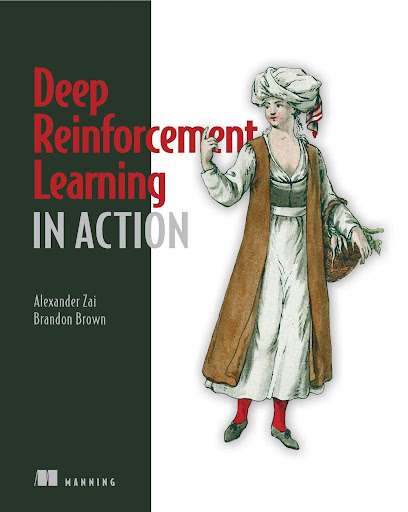
Product Details:
This reinforcement process can be applied to computer programs allowing them to solve more complex problems that classical programming cannot. deep reinforcement learning in action teaches you the fundamental concepts and terminology of deep reinforcement learning, along with the practical skills and techniques you’ll need to implement it into your own projects. purchase of the print book includes a free ebook in pdf, kindle, and epub formats from manning publications. about the technology deep reinforcement learning ai systems rapidly adapt to new environments, a vast improvement over standard neural networks. a drl agent learns like people do, taking in raw data such as sensor input and refining its responses and predictions through trial and error. about the book deep reinforcement learning in action teaches you how to program ai agents that adapt and improve based on direct feedback from their environment. in this example-rich tutorial, you’ll master foundational and advanced drl techniques by taking on interesting challenges like navigating a maze and playing video games. along the way, you’ll work with core algorithms, including deep q-networks and policy gradients, along with industry-standard tools like pytorch and openai gym. what's inside building and training drl networks the most popular drl algorithms for learning and problem solving evolutionary algorithms for curiosity and multi-agent learning all examples available as jupyter notebooks about the reader for readers with intermediate skills in python and deep learning. about the author alexander zai is a machine learning engineer at amazon ai. brandon brown is a machine learning and data analysis blogger. table of contents part 1 – foundations 1. what is reinforcement learning? 2. modeling reinforcement learning problems: markov decision processes 3. predicting the best states and actions: deep q-networks 4. learning to pick the best policy: policy gradient methods 5. tackling more complex problems with actor-critic methods part 2 – above and beyond 6. alternative optimization methods: evolutionary algorithms 7. distributional dqn: getting the full story 8. curiosity-driven exploration 9. multi-agent reinforcement learning 10. interpretable reinforcement learning: attention and relational models 11. in conclusion: a review and roadmap
Reviews:
I've scored the book after reading only two chapters. Seems valuable.
The book is written for humans and is a great supplement for old reinforcement learning books which focus mainly on mathematics behind (policy gradient theorem, q function approximations etc.) I wouldnt recommend to use this book without mathematically oriented ones, because it misses too many important details. It is definitelly a great book which shows many examples together with explanations which are more practically oriented.Frankie
13. Deep Learning With Tensorflow 2 And Keras: Regression, Convnets, Gans, Rnns, Nlp, And More With Tensorflow 2 And The Keras Api [Book]

Product Details:
Build machine and deep learning systems with the newly released tensorflow 2 and keras for the lab, production, and mobile deviceskey features introduces and then uses tensorflow 2 and keras right from the start teaches key machine and deep learning techniques understand the fundamentals of deep learning and machine learning through clear explanations and extensive code samples book description deep learning with tensorflow 2 and keras, second edition teaches neural networks and deep learning techniques alongside tensorflow (tf) and keras. tensorflow is the machine learning library of choice for professional applications, while keras offers a simple and powerful python api for accessing tensorflow. tensorflow 2 provides full keras integration, making advanced machine learning easier and more convenient than ever before. this book also introduces neural networks with tensorflow, runs through the main applications (regression, convnets (cnns), gans, rnns, nlp), covers two working example apps, and then dives into tf in production, tf mobile, and using tensorflow with automl. what you will learn build machine learning and deep learning systems with tensorflow 2 and the keras api use regression analysis, the most popular approach to machine learning understand convnets (convolutional neural networks) and how they are essential for deep learning systems such as image classifiers use gans (generative adversarial networks) to create new data that fits with existing patterns discover rnns (recurrent neural networks) that can process sequences of input intelligently, using one part of a sequence to correctly interpret another apply deep learning to natural human language and interpret natural language texts to produce an appropriate response train your models on the cloud and put tf to work in real environments explore how google tools can automate simple ml workflows without the need for complex modeling who this book is for this book is for python developers and data scientists who want to build machine learning and deep learning systems with tensorflow. whether or not you have done machine learning before, this book gives you the theory and practice required to use keras, tensorflow 2, and automl to build machine learning systems.
Reviews:
14. Learning Deep Learning: Theory And Practice Of Neural Networks, Computer Vision, Natural Language Processing, And Transformers Using Tensorflow [Book]
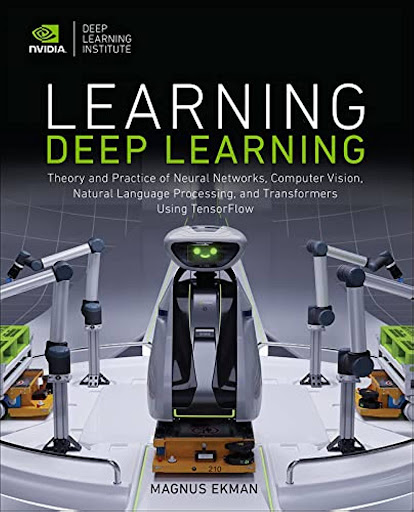
Product Details:
Nvidia's full-color guide to deep learning: all you need to get started and get results "to enable everyone to be part of this historic revolution requires the democratization of ai knowledge and resources. this book is timely and relevant towards accomplishing these lofty goals." — from the foreword by dr. anima anandkumar, bren professor, caltech, and director of ml research, nvidia "ekman uses a learning technique that in our experience has proven pivotal to success–asking the reader to think about using dl techniques in practice. his straightforward approach is refreshing, and he permits the reader to dream, just a bit, about where dl may yet take us." — from the foreword by dr. craig clawson, director, nvidia deep learning institute deep learning (dl) is a key component of today's exciting advances in machine learning and artificial intelligence. learning deep learning is a complete guide to dl. illuminating both the core concepts and the hands-on programming techniques needed to succeed, this book is ideal for developers, data scientists, analysts, and others–including those with no prior machine learning or statistics experience. after introducing the essential building blocks of deep neural networks, such as artificial neurons and fully connected, convolutional, and recurrent layers, magnus ekman shows how to use them to build advanced architectures, including the transformer. he describes how these concepts are used to build modern networks for computer vision and natural language processing (nlp), including mask r-cnn, gpt, and bert. and he explains how a natural language translator and a system generating natural language descriptions of images. throughout, ekman provides concise, well-annotated code examples using tensorflow with keras. corresponding pytorch examples are provided online, and the book thereby covers the two dominating python libraries for dl used in industry and academia. he concludes with an introduction to neural architecture search (nas), exploring important ethical issues and providing resources for further learning. explore and master core concepts: perceptrons, gradient-based learning, sigmoid neurons, and back propagation see how dl frameworks make it easier to develop more complicated and useful neural networks discover how convolutional neural networks (cnns) revolutionize image classification and analysis apply recurrent neural networks (rnns) and long short-term memory (lstm) to text and other variable-length sequences master nlp with sequence-to-sequence networks and the transformer architecture build applications for natural language translation and image captioning nvidia's invention of the gpu sparked the pc gaming market. the company's pioneering work in accelerated computing–a supercharged form of computing at the intersection of computer graphics, high-performance computing, and ai–is reshaping trillion-dollar industries, such as transportation, healthcare, and manufacturing, and fueling the growth of many others. register your book for convenient access to downloads, updates, and/or corrections as they become available. see inside book for details.
15. Matlab Deep Learning: With Machine Learning, Neural Networks And Artificial Intelligence [Book]

Product Details:
Get started with matlab for deep learning and ai with this in-depth primer. in this book, you start with machine learning fundamentals, then move on to neural networks, deep learning, and then convolutional neural networks. in a blend of fundamentals and applications, matlab deep learning employs matlab as the underlying programming language and tool for the examples and case studies in this book. with this book, you'll be able to tackle some of today's real world big data, smart bots, and other complex data problems. you’ll see how deep learning is a complex and more intelligent aspect of machine learning for modern smart data analysis and usage. – what you'll learn – use matlab for deep learning – discover neural networks and multi-layer neural networks – work with convolution and pooling layers – build a mnist example with these layers – who this book is for – those who want to learn deep learning using matlab. some matlab experience may be useful.
16. Deep Learning: Engage The World Change The World [Ebook]

Product Details:
Engage the world change the world deep learning has claimed the attention of educators and policymakers around the world. this book not only defines what deep learning is, but takes up the question of how to mobilize complex, whole-system change and transform learning for all students. deep learning is a global partnership that works to: transform the role of teachers to that of activators who design experiences that build global competencies using real-life problem solving; and supports schools, districts, and systems to shift practice and how to measure learning in authentic ways. this comprehensive strategy incorporates practical tools and processes to engage students, educators, and families in new partnerships and drive deep learning.
Specifications:
| File size | 9 MB |
Reviews:
17. Deep Learning [Ebook]

Product Details:
An introduction to a broad range of topics in deep learning, covering mathematical and conceptual background, deep learning techniques used in industry, and research perspectives.“ written by three experts in the field, deep learning is the only comprehensive book on the subject.”—elon musk, cochair of openai; cofounder and ceo of tesla and spacexdeep learning is a form of machine learning that enables computers to learn from experience and understand the world in terms of a hierarchy of concepts. because the computer gathers knowledge from experience, there is no need for a human computer operator to formally specify all the knowledge that the computer needs. the hierarchy of concepts allows the computer to learn complicated concepts by building them out of simpler ones; a graph of these hierarchies would be many layers deep. this book introduces a broad range of topics in deep learning. the text offers mathematical and conceptual background, covering relevant concepts in linear algebra, probability theory and information theory, numerical computation, and machine learning. it describes deep learning techniques used by practitioners in industry, including deep feedforward networks, regularization, optimization algorithms, convolutional networks, sequence modeling, and practical methodology; and it surveys such applications as natural language processing, speech recognition, computer vision, online recommendation systems, bioinformatics, and videogames. finally, the book offers research perspectives, covering such theoretical topics as linear factor models, autoencoders, representation learning, structured probabilistic models, monte carlo methods, the partition function, approximate inference, and deep generative models. deep learning can be used by undergraduate or graduate students planning careers in either industry or research, and by software engineers who want to begin using deep learning in their products or platforms. a website offers supplementary material for both readers and instructors.
Specifications:
| MIT Press | November 2016 |
| Imprint | The MIT Press |
| Language | English |
Reviews:
Amazing book and quality. Well packaged, every page is clear and compact! Highly recommend!!tedxwkk
Very heavy on math. Not a good introductory book.stephen10605
18. Hands-On Machine Learning With Scikit-Learn And Tensorflow: Concepts, Tools, And Techniques To Build Intelligent Systems [Book]

Product Details:
Graphics in this book are printed in black and white. – through a series of recent breakthroughs, deep learning has boosted the entire field of machine learning. now, even programmers who know close to nothing about this technology can use simple, efficient tools to implement programs capable of learning from data. this practical book shows you how. – by using concrete examples, minimal theory, and two production-ready python frameworks–scikit-learn and tensor – flow–author aurélien géron helps you gain an intuitive understanding of the concepts and tools for building intelligent systems. you'll learn a range of techniques, starting with simple linear regression and progressing to deep neural networks. with exercises in each chapter to help you apply what you've learned, all you need is programming experience to get started. – explore the machine learning landscape, particularly neural nets – use scikit-learn to track an example machine-learning project end-to-end – explore several training models, including support vector machines, decision trees, random forests, and ensemble methods – use the tensorflow library to build and train neural nets – dive into neural net architectures, including convolutional nets, recurrent nets, and deep reinforcement learning – learn techniques for training and scaling deep neural nets – apply practical code examples without acquiring excessive machine learning theory or algorithm details
Specifications:
| Language | English |
| Release Date | April 2017 |
| Length | 574 Pages |
| Dimensions | 1.1" x 6.9" x 9.0" |
Reviews:
Great book, was exactly what I was looking for!jettsun7
This is hands down the best Machine Learning book in the market. You will not regret buying it.Dani
19. Hands-On Machine Learning With Scikit-Learn And Tensorflow: Concepts, Tools, And Techniques To Build Intelligent Systems [Book]

Product Details:
Graphics in this book are printed in black and white. – through a series of recent breakthroughs, deep learning has boosted the entire field of machine learning. now, even programmers who know close to nothing about this technology can use simple, efficient tools to implement programs capable of learning from data. this practical book shows you how. – by using concrete examples, minimal theory, and two production-ready python frameworks–scikit-learn and tensor – flow–author aurélien géron helps you gain an intuitive understanding of the concepts and tools for building intelligent systems. you'll learn a range of techniques, starting with simple linear regression and progressing to deep neural networks. with exercises in each chapter to help you apply what you've learned, all you need is programming experience to get started. – explore the machine learning landscape, particularly neural nets – use scikit-learn to track an example machine-learning project end-to-end – explore several training models, including support vector machines, decision trees, random forests, and ensemble methods – use the tensorflow library to build and train neural nets – dive into neural net architectures, including convolutional nets, recurrent nets, and deep reinforcement learning – learn techniques for training and scaling deep neural nets – apply practical code examples without acquiring excessive machine learning theory or algorithm details
Specifications:
| Language | English |
| Release Date | April 2017 |
| Length | 574 Pages |
| Dimensions | 1.1" x 6.9" x 9.0" |
Reviews:
Great book, was exactly what I was looking for!jettsun7
This is hands down the best Machine Learning book in the market. You will not regret buying it.Dani
20. Deep Learning With R [Book]
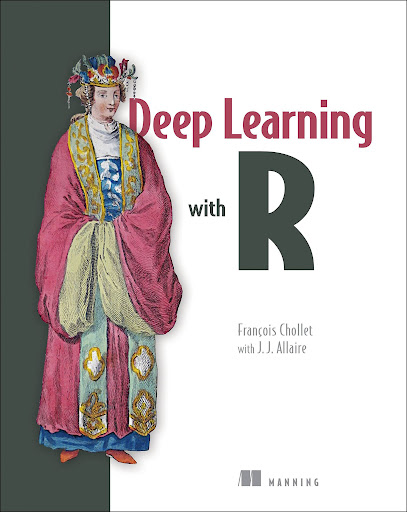
Product Details:
Summary – deep learning with r introduces the world of deep learning using the powerful keras library and its r language interface. purchase of the print book includes a free ebook in pdf, kindle, and e – pub formats from manning publications. – about the technology – machine learning has made remarkable progress in recent years. deep-learning systems now enable previously impossible smart applications, revolutionizing image recognition and natural-language processing, and identifying complex patterns in data. the keras deep-learning library provides data scientists and developers working in r a state-of-the-art toolset for tackling deep-learning tasks. – about the book – deep learning with r introduces the world of deep learning using the powerful keras library and its r language interface. initially written for python as deep learning with python by keras creator and google ai researcher françois chollet and adapted for r by rstudio founder j. you'll practice your new skills with r-based applications in computer vision, natural-language processing, and generative models. – what's inside – deep learning from first principles – setting up your own deep-learning environment – image classification and generation – deep learning for text and sequences – about the reader – you'll need intermediate r programming skills. no previous experience with machine learning or deep learning is assumed. – about the authors – françois chollet is a deep-learning researcher at google and the author of the keras library. allaire is the founder of rstudio and the author of the r interfaces to tensor – flow and keras. – table of contents – part 1 – fundamentals of deep learningwhat is deep learning? – getting started with neural networks – fundamentals of machine learning – part 2 – deep learning in practicedeep learning for computer vision – deep learning for text and sequences – advanced deep-learning best practices – generative deep learning – conclusions


